When thinking of Africa generally the first thought that comes to our mind is the Safari.
Not without reason, given that Africa is the only continent in the world that allows you to travel through national parks where some of the most amazing animals, and aggressive, of the earth cohabit, from lions to hippos surrounded by zebras, gnu or the majestic and elegant giraffe.
Tanzania is the king country to live this experience given the high number of national parks, including the famous Serengeti (which for many, especially children, is easy to identify as the background from The Lion King) and Ngongoro crater, the largest crater in the world.
Actually, Tanzania offers many other parks, some of which even face the sea, and there is plenty of choices when planning a trip like this in this country.
The many available choices also give way to confusion and consequently to difficulty in planning. The purpose of this post is to help in the planning of your safari considering several factors including budget, which might be what in the end will lead you to opt for one solution over another.
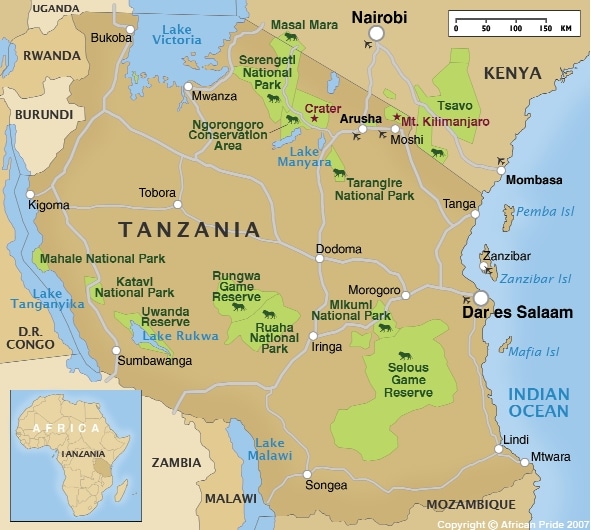
National Parks and Nature Reserve in Tanzania
The subject is very complex and choosing the right safari can be determined by many factors, so take your time and read all the paragraphs. Obviously, if you have any questions or doubts do leave a comment on this post and I'll be happy to answer you!
___________________________________
___________________________________
The budget needed for a safari in Tanzania, which is considered the most expensive but also the most beautiful in Africa, must be pretty high also choosing the most thrifty solution, sleeping in tents; generally, for the main circuit (north) the rate would range around $ 250 per person per day, all-inclusive, in high season, for a car for two people (if you are in the cost would get lower).
The more the category of accommodation rises, the higher the price increases. The cheapest solution is camping in a tent, which is generally included in the price.
It is also true that other parks in Tanzania offer cheaper safari since the entry cost would be lower, be advised that most of the money goes to the rental car, park fees, petrol and accommodation.
Rates would start from 200/250 per person per day, a little less if participants are more than two.
To minimize expense if you travel alone or in couple, you can find fellow travelers on travel forums or you can ask the agency that organizes the safari whether there are other travelers who are looking for companions and join them. In this case the dates won’t be flexible.
Below you find the link to a few useful Forums to search for travel companions:
Lonely Planet TornThree Tanzania
TripAdvisor Tanzania Forum
TravellersPoint
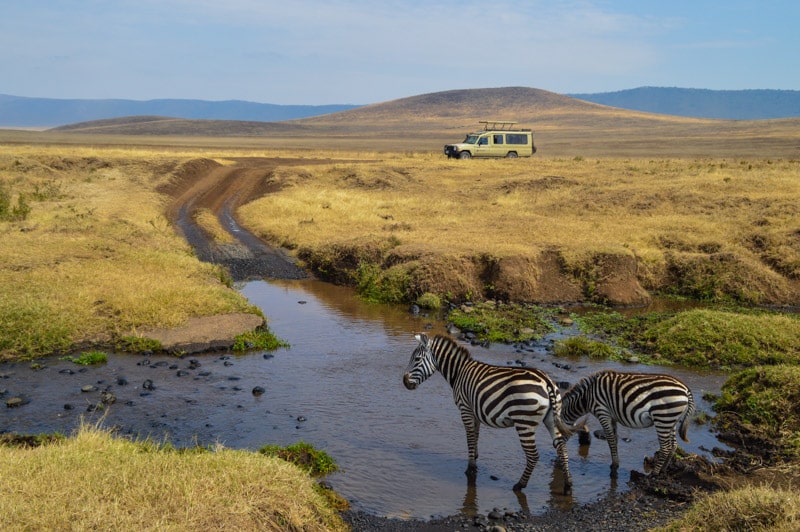
Safari can be done in self-drive, you rent a car and you do everything independently, but perhaps it is not worth it as in this case a guide is essential.
They know how to drive in the parks, communicate with each other by radio in case there are interesting animals (and they do it in swhaili), they have eyes trained to spot animals in the savanna which would be hard for unaccustomed eyes.
Not only this, the driver/guide even knows how to repair a car or in case of damage they would know where to go; those opting for self-drive could find themselves in need of a mechanic and the same problem with looking for a chef, that if you sleep in a camp, is necessary.
For a minimum saving you might face trip potentially problematic.
Self-drive is probably a good choice outside the national parks but within I believe that the presence of a guide/driver would simplify the journey and above all, it represents an added value that is worth the price difference.
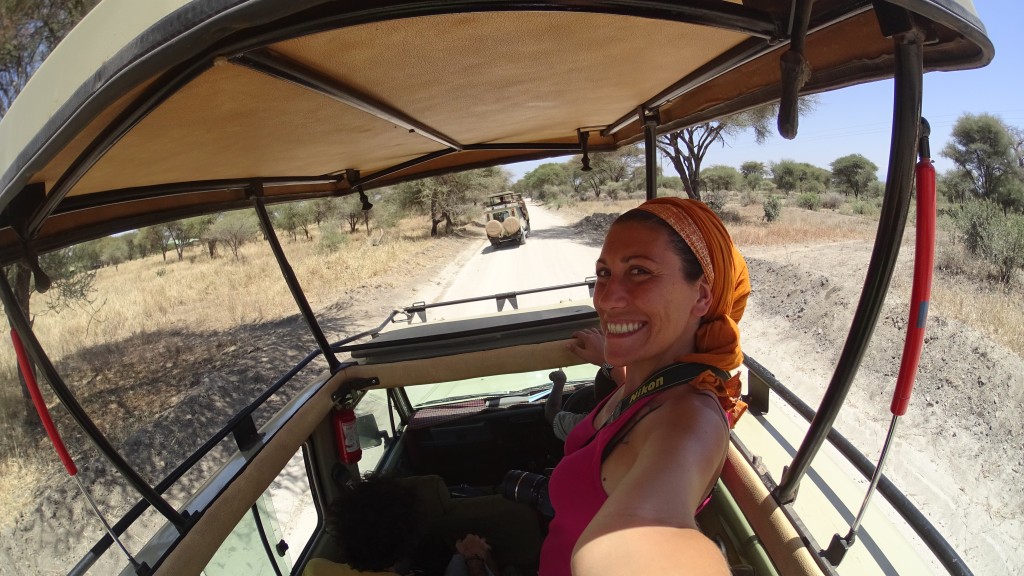
Although safari in groups in Tanzania is not very common, (lucky I did not meet trucks with 30 people on board…), some agencies would put together 2 or more travelers to lower the cost.
The maximum number of people recommended per car is 4 to allow everyone to stand off the roof without taking turns to photograph but also to make this experience unique and personal without having to wait for the others who, in some cases, can belong not allowing the others to do what they’d wish to.
Some cars can carry up to 6/8 people but unless you are part of a group all together, be advised that with this choice you may risk remaining sitting waiting for your turn to stand or worse some might decide to move to see more animals while others would rather stay put to see some more.
The guide in fact takes you to see the animals, but it is you saying when to proceed or when to stop. If a person in the car is for example particularly interested in the birds and we are not, then there could arise misunderstandings or waiting time that could have been avoided if we were alone.
There are all reasons why it is preferable to opt for a private safari or at least for a group of no more than 4 people.[/tg_accordion]
Much of the final cost depends on the type of accommodation you choose during your safari.
I emphasize this because it is right to do so, even in the most economical and basic solution, the tent, the cost will still be high and will exceed one thousand dollars per person for six days in the parks in the North.
Lodging options are as follows:
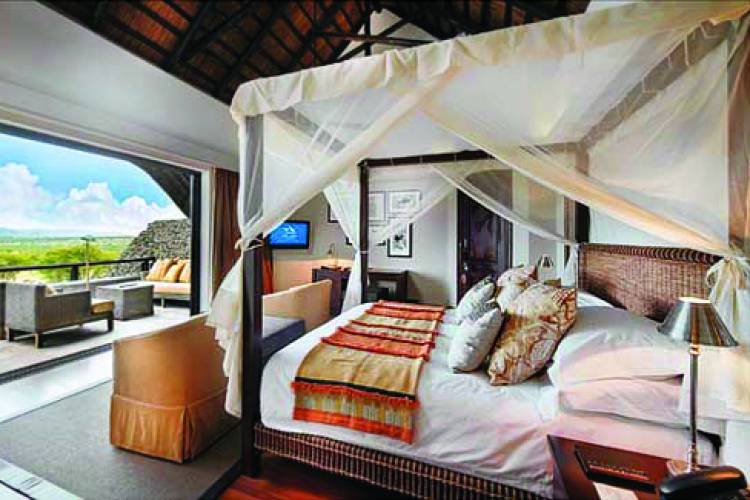
Luxury Lodge
The most expensive solutions for those who can afford it will make the safari exceed all expectations, both when driving in the park and when you get into superb environments; the rooms are tastefully decorated with the highest quality materials, the service is impeccable.
Standard Lodges
The standard lodges correspond more or less to our 3 stars, some have swimming pools and bar and meals are served at the restaurant.
All rooms have private bathrooms and air conditioning.
Permanent tented camps
The permanent tented camps are a good compromise between the standard lodges and camping, sometimes they are even higher quality than the standard ones and definitely a happy choice to enjoy the nature of the national parks in a situation "without walls".
These are permanent tents with beds, private bathrooms and hot showers. All tented camps offer restaurants, bars and some have swimming pools.
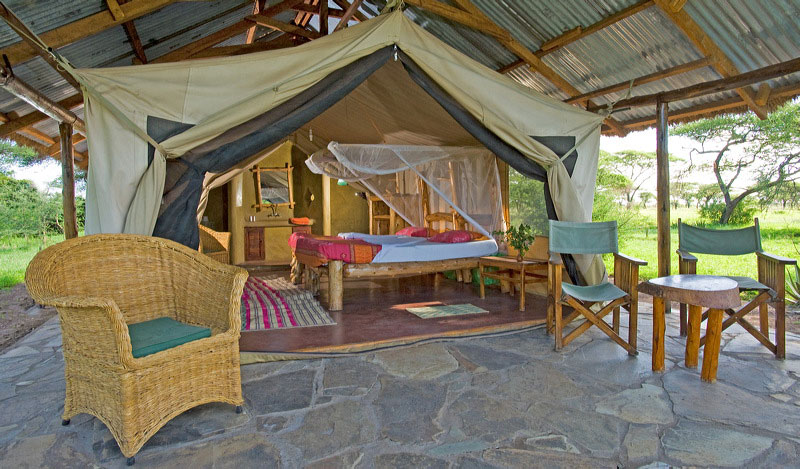
Camping (public and special)
This is the cheapest and most basic solution, the one for which of course I did opt. In the camp are offered basic services, shared bathroom and hall equipped with tables for breakfast and dinner. Meals are served outdoors and in sheltered areas. Travelers sleeping in a camp will necessarily require a cook. There are no restaurants nor bars.
Ideal for those on a budget but also for those who have a high sense of adaptation, it is after all tents, no hot water and there are about 4 bathrooms (4 for women and 4 for men) for the entire Camping area.
Besides the public campsite in the Serengeti is in the heart of the park and there are NO walls nor networks, it may therefore happen that in the evening an elephant, a habitué of the camp, would come to raid the remains or hyenas would stroll between the tents at night.
The safari is a wonderful experience for adults and children given the amount of animals that you will see, but at the same time it is also a pretty tough journey, which will force you to endure a lot of dust, heat, and fatigue.
Camping, unless you are used to basic environments and uncomfortable situations, perhaps might not be indicated for younger children, which among other things, as there are no fences, would force you to always be vigilant, preventing them to run around or wander alone without supervision.
For those traveling with children, the best solution is to opt for the tented camps or lodges, to be able to rest and relax but above all NEVER leave children alone.
Not all lodges accept children, until a few years ago children too young were not allowed in the Parks, this was for a reason, but according to my opinion, not being a mother myself, the minimum age to enjoy of this "once in a lifetime" trip is at least 7/8 years.
It is worth to wait to keep into account the hardship of a journey into the heart of the wilderness.
Most important is never to let children play outside especially at sunset, it is, after all, a dangerous environment and more precaution is not a bad thing, this applies to any kind of accommodation you choose.
The season is quite important in deciding when to make your safari. The high seasons are the periods of migration of Gnu, so January/February and July/August.
Actually apart from the rainy months, April/May, the rest of the year offers possibilities for exceptional safari.
Even in the two months of low season, a time when it will rain but the vegetation is very green, you can still see the animals, although I would say that these might be for months to avoid if you wish to combine this trip with some island (Zanzibar or Mafia for example), since many lodges close and the rains would make the stay quite futile.
Specifically for safari this information may come in handy.
Info in short:
Best period - From June to October (valid for all the parks). Especially July, January and February are the best months to visit the Serengeti for the Gnu migration and because it is the months when the animals give birth.
High Season - From July to September for the parks of the northern circuit, but they are quite crowded - July/October for the parks of the southern and western circuit that anyway are never as crowded as those in the north.
Low Season - April and May because it is the rainy season. The parks of the northern circuit still receive visitors while those in the south and west circuit are very rarely visited and many hotels close during these months.
Best weather- From June to October, with little or no rain
Worst weather - From March to April, the peak of the rainy season.
From June to October ( dry season )
From November to May ( rainy season )
Best season to travel in Tanzania
Serengeti and the Ngorongoro Crater offer a fine observing point of wildflowers throughout the year, but June and July are considered the best months for migration while February for the births and so the arrival of the cubs.
Tarangire park and the Southern and Western parks ( Kayavi , Selous and Ruaha ) are wonderful if you visit them during the dry season which stretches from June to October.
According to the park of your choice and the budget available, the duration of the safari is variable, especially if it is customized, which makes the schedule more flexible.
If you want to visit the northern parks and considering that the main reason you decided to undertake this trip probably is this experience, the ideal would be 6 days and 5 nights, starting from Arusha to touch the parks Manyara, Tarangire, Ngongoro Crater, and Serengeti.
For those who wish to have a shorter safari together with the guide we may come up with different routes, fit for the available days.
Actually, you can choose some parks rather than others based on the budget, for example, opt for Ruha Nation Park, in the heart of Tanzania or the Selous or Saadani (advertised as the park where the savanna meets with the sea) where the entrance fees for parks and housing are cheaper, and therefore the costs are significantly lower.
[/tg_accordion]
This is an important issue because in planning a safari not only the animals are involved but also the people who work for us.
I know, Safari is expensive, it was probably the most expensive travel experience I've ever done, overtaking the record that until now was held by the Galapagos and that somehow is very close to this one given that they are trips within protected national parks.
It is of the utmost importance to know that the less you pay for a safari the less the driver/guide and the cook are paid. In some cases they do not receive any remuneration from the operator that organizes the safari, that's why you're paying less.
It wasn't the case of Wiliam and KibokoExplorer that, actually, explained to me all this.
The tip in these cases is the only source of income for these people, there have been cases where it was reported that the treatment was very bad and guides unsociable or unprepared, or that at the end of the trip $30/40 per day per participant tip was required to be divided between the guide and cook.
Anyways, who likes to work for free?
Pay attention to prices then, but remember that the less you pay the more you are taking advantage of people who work for free and that at the end of the journey will demand compensation from you that corresponds roughly to $15/20 per person per day for the driver and at least $10 per person per day for the cook.
If the service was good however it is a good custom to leave something more, given that average salaries are very low, and when traveling you will realize how hard the job is (actually also for the participant it is a very intense experience).
Before booking a safari make sure that the people who work for you are paid in the appropriate manner and if the safari offered sounds too cheap remember that most likely your guides are not getting any salary and you, without knowing it, are taking advantage of workers.
Do not be afraid to ask your driver if and how much he is paid.
If he doesn’t answer the reason is that he was forbidden by the agency to give such information. And this would provide the answer you seeked.
Ethical travel in this case involves respect for animals but also for all those people who’ll make your trip outstanding and unique, so do not take advantage of them!
List of gadgets that those who are about to experience the safari shouldn’t be without:
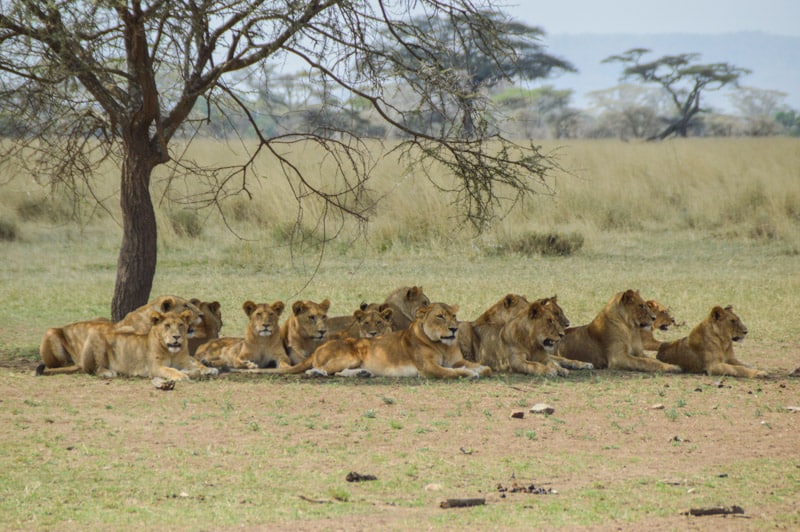
All guides advise to wear light-colored clothing, and I must admit that I have seen so many safari tourers go around with white shirts and properly dressed.
Now it really takes little to realize that the people of these countries do not wear anything in light tones, but indeed blue and red are the utmost, but I would say it's crazy to buy a new wardrobe just for the occasion and really there is no need.
My advice is to travel with comfortable clothing, avoid white, which is bound to turn earthly brown quickly and bring a change per day given the conditions in which you will arrive at the end of each day.
Avoid the blue and black colors that attract tsetse flies and white for the dirt.
Clothing made of natural fibers, such as cotton, is very convenient for traveling in tropical Africa. It is advisable to wear long-sleeved shirts and long pants from dusk to dawn when insects appear and the risk of malaria rises.
During the dry season, it's good to carry a sweater or jacket for early morning and evening.
Highly recommended also a bandana to protect yourselves from the dust that inevitably will get to you while standing in the car and meeting with a car coming from the opposite direction: you will want to cover nose, mouth and ears.
The risk of malaria exists in most African countries, with the exception of Lesotho and South Africa.
There is no vaccine against malaria, therefore what you need to do is following prophylaxis against it and combine it with repellent to put on every day and evening, mosquitoes are especially active at dusk and dawn.
The vaccine for yellow fever is compulsory if you enter Tanzania from Kenya or from another country where this is endemic.
There are therefore no compulsory vaccines but vaccines for the Hepatitis A, B, polio, rabies, typhoid and meningitis are recommended.
It is highly advisable to have travel insurance that will cover medical expenses in case of illness. To get travel insurance you can make a request for a quotation to our partners World Nomads.
A trip to Tanzania is not just a safari, this country is huge and it offers so many attractions including some of the best dives in the world, trekking or Swahili villages.
Tanzania has three main airports: Dar Es Salaam, Kilimanjaro and Zanzibar.
For those interested mainly in the safari in the northern circuit, it is a convenient landing at Kilimanjaro: safaris in fact depart from Arusha and not, as you might believe, from Dar Es Salaam.
From this same airport after the safari you can fly to Zanzibar or Mafia, the journey on land would take at least two rather tiresome days for Zanzibar while to reach Mafia things get complicated, read here to find out more.
If you arrive in Dar Es Salaam you can arrange a transfer to Arusha but the guide requires at least a day trip to which you need to add, as usually flights land in the evening, a night in town. A bit inconvenient for those who start with the safari but perhaps more convenient for those leaving from Zanzibar. But each case is different in itself. Considering the condition of the roads it is probably preferable, although more expensive, flying to Kilimanjaro and from there proceed towards the chosen venues.
[/tg_accordion]
[tg_accordion title="Books and guides to prepare yourself for a safari and a trip" icon="fa-paper-plane" close="1"]
List of books and guides to buy to prepare for a safari ( journey ) in Tanzania
Tanzania Safari Guide: With Kilimanjaro, Zanzibar and the coast (Bradt Travel Guide) - suitable for those interested in safaris in the Northern circuit combining also Zanzibar
Lonely Planet Tanzania (Travel Guide) - Recommended for those who want to visit the alternative parks or travel along South and West Tanzania
The Shadow of the Sun - This book is not about Africa, but about people who live there and whom I have met, of the time we spent together. Africa is a continent much too large to be able to describe in full. It is an ocean, a planet in its own right, a cosmos varied and rich. And it is only to simplify and for sheer convenience that they call it Africa. Apart from its geographical denomination, as a fact Africa does not exist. The narration, ethic and haunting, of a great reporter, passionate and expert of Africa, who has the courage to live his job through, as nomadism and redemption.
Out of Africa (Modern Library 100 Best Nonfiction Books)- Karen Blixen, who lived up to '31 in a farm in a coffee plantation in the highlands of Ngong, described with a unparalleled clarity her loving relation with a continent. Supremely distant from politics, she gave us perhaps the most beautiful portrait of Africa, its nature, its colors, its inhabitants. The Kikuyu that nothing can surprise aymore, the fierce and passionate Somali of the desert, the Masai who watch from their reserve in which they are prisoners condemned to extinction, the advance of a civilization "that deep in their hearts they hate more than anything else in the world". People, trees, animals live in the pages of Blixen composing arabesques never evasive, in a dense network of descriptions and feelings that, beyond their documentary value, refer to the wisdom of this fabulous great writer, affecting significantly the content of her art.
Mamma Africa. Una storia vera - There Is No Me Without You: One Woman's Odyssey to Rescue Africa's Children - The story of Haregwoin Teferra, hero by chance in Addis Ababa, who changed her deep sorrow for the death of her husband and daughter in the courage to accept and raise AIDS orphans. Haregwoin was on the brink of a deep depression when the priest of her village brought to her two kids, children of two of the millions of deaths that HIV causes in Africa. Despite resistance from her family, she took them and with them she began to live once again. But this was only the beginning. The word spread quickly, and every day, knocking at her door now, she would open her home to HIV-positive parents who were dying, begging her to accommodate their children. Beyond all economic and common sense, Haregwoin new family went on growing, creating a real refuge for orphans and a refuge for the sick mothers. Between narrative and complaint, the author focuses the attention on a forgotten holocaust, with over twenty million victims just in Africa.
Leaving Before the Rains Come - Alexandra, daughter of English immigrants in Africa in the early '70s, spent her childhood and early youth in Rhodesia. This is where she’ll meet K., the protagonist of this memoir. K. is apparently a man full of contradictions: marked by work in the fields, he is a real lion, wild, "bullet-proof". A survivor of the earth that he contributed to forge but at the same time also the fruit of that same land that shaped his being. Together they embark on a journey - looking for themselves and their own past - in the African jungle, in the land of lions, leopards, mosquitoes, fevers, but also of ambushes, wars, landmines.
The Rain Queen - A tragic past has marked the childhood and life of Kate: her parents, missionaries in Tanzania in the sixties, were killed during a tribal war. That trauma suddenly emerges from the encounter with Annah, who needs to tell her story as well as Kate needs to listen. Annah, missionary in Africa, was tied to Kate’s parents by mixed and tormented feelings: to her father Michael from a secret denied passion, to the mother Sarah from a deep and indissoluble friendship. This impossible triangle led her to integrate deeply with a tribe and marry the leader, and become the pupil of an old "woman sorcerer" who teaches her the secrets of white magic.
Planning advices
I would advise considering two extra days, one before the start of the safari and one right afterward, although you get around by car, distances are too far and it is a journey intense and wearisome. It is recommended to rest before undertaking it and take an extra day after, maybe planning to hike to the base camp of Kilimangiario, without actually climbing all the way up, or roam the streets of Arusha, heading to the market even if the city does not offer much as it is primarily a center dedicated to the organization of the safari.[
Disclaimer: In questo post, alcuni dei link forniti sono link di affiliazione, il che significa che posso guadagnare una commissione se si effettua un acquisto attraverso questi collegamenti. Tuttavia, ciò non comporta nessun costo aggiuntivo per te. Le commissioni che ricevo attraverso questi link di affiliazione aiutano a finanziare e supportare il mio blog, mantenendo così la sua indipendenza e la mancanza di sponsorizzazioni. Mi sforzo sempre di fornirti le migliori informazioni e consigli possibili, basati sulla mia esperienza e ricerca personale. Mi preme sottolineare che il tuo sostegno è fondamentale per mantenere vivo questo blog e continuare a fornirti contenuti di qualità. Grazie per il tuo supporto!
Alcune immagini pubblicate sono state tratte da Internet, nel caso in cui, il loro utilizzo, violasse diritti d’autore, mandateci una mail a [email protected] e verranno immediatamente rimosse.
i would like to do a safari, can you conctact as soon as possible please.
Gabriel Armanu
07533585584
Hello Gabril,
you can write an email to giulia AT kipepeoexperience.com I will be pleased to help you with the safari in Tanzania.
Regards
Giulia
Viaggiare Low cost is reliable travel marketplace for planning and booking Africa wildlife tours such as Tanzania safari and Kilimanjaro climb. Affordable travel packages include budget Tanzania safaris and cheap Kilimanjaro trekking adventures.
Travel Agents can partner with DMC Tanzania travel company - KILIMANJARO TANZANITE SAFARIS Co.Ltd....and tourists can book direct.
Nice post